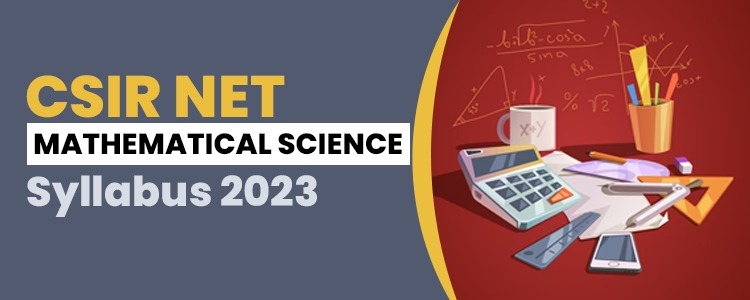CSIR NET Mathematical Science Syllabus 2023

Contents
1. CSIR NET Mathematics Syllabus Overview
2. CSIR NET Mathematical Science Syllabus 2023 (Updated)
3. CSIR NET Mathematical Science 2023 Subject Wise
4. CSIR NET Mathematical Science Topic wise Weightage
5. CSIR NET Mathematical Science Syllabus 2023 Download
6. CSIR NET Mathematical Science Syllabus FAQs
CSIR NET Mathematical Science Syllabus 2023 Overview
The Joint CSIR UGC NET exam is conducted bi-annaully to select and determine the best candidates for the position of Assistant Professor as well as Junior Research Fellow in prominent Institutes and Universities across India. The notification for the same was released on 10th March 2023 and the last day to apply for this exam is on 10th April 2023. The exam is scheduled for the month of June 2023. And the paper is basically divided into three parts viz., part-A, part-B and part-C. The exam will be conducted within a duration of 3 hours with a total of 200 questions.
CSIR NET Mathematical Science Syllabus 2023 (Updated)
The part ‘A’ syllabus consists of questions pertaining to General Science, Quantitative Analysis & Reasoning and Research Aptitude. And the part ‘B’ portions cover general topics specific to the core subject. The last portion or part ‘C’ reflects an advanced level of application type questions.
CSIR NET Mathematical Science 2023 Subject Wise
The CSIR NET Mathematical science paper has a stratified curriculum that pertains to the undergraduate as well as the post-graduate level Physics offered during the University study.
CSIR NET Mathematical Science Syllabus Part B & C – Core
|
Main Topics |
Sub-topics |
|
UNIT-1 | |
|
1. Analysis
|
|
|
2. Linear Algebra |
|
|
UNIT-2 | |
|
1. Complex Analysis |
|
|
2. Algebra |
|
|
3. Topology |
|
|
UNIT-3 | |
|
1. Ordinary Differential Equations (ODEs) |
|
|
2. Partial Differential Equations (PDEs) |
|
|
3. Numerical Analysis |
|
|
4. Calculus of Variations |
|
|
5. Linear Integral Equations |
|
|
6. Classical Mechanics |
|
|
UNIT-4 | |
|
1. Descriptive Statistics, Exploratory data analysis |
|
CSIR NET Mathematical Science Topic wise Weightage
The mark scheme, number of questions and number of questions that the candidate require to attempt in each section are given below. Applicants should also note that there will be negative marks at 25% which vary depending upon the weightage of marks allotted in each section. However, there will be no negative marking for part ‘C’ in Mathematical Science paper.
|
Parts |
Subjects |
Tot QN |
Attempt QN |
Marks |
Negative marks |
|
Part ‘A’ |
|
20 |
15 |
2 |
0.5 |
|
Part ‘B’ |
|
40 |
25 |
3 |
0.75 |
|
Part ‘C’ |
(Application type) |
60 |
20 |
4.75 |
nil |
*Tot QN – Total number of questions
*Attempt QN – Total number questions required to attempt
CSIR NET Mathematical Science Syllabus 2023 Download
The detailed syllabus for the CSIR UGC NET Mathematical Science is given below in pdf format. Please download from the below link.
CSIR NET Mathematical Science Syllabus FAQs
1. How Many Papers are there in CSIR NET Exam?
There are a total of 5 subjects for which the Joint CSIR UGC NET is conducted. They are Chemical Sciences, Earth, Atmospheric, ocean and Planetary Sciences, Life Sciences, Mathematical Sciences and Physical Sciences.
2. CSIR NET mathematical Science previous year Cut-offs?
|
Category |
JRFs |
LS |
|
UR |
48.38 |
43.543 |
|
EWS |
42.75 |
38.475 |
|
OC |
40.5 |
36.450 |
|
SC |
32.38 |
29.142 |
|
ST |
27.13 |
25.00 |
|
PwD |
25 |
25.000 |
3. Out of what total marks is CSIR NET Mathematical Science exam conducted?
The CSIR NET Exam is conducted out of a total mark of 200.
4. Best Books for CSIR NET Mathematical Science?
Some of the best books for CSIR UGC NET Mathematical Science that can accelerate your preparations are given below:
- Ordinary and Partial Differential Equations by Dr M D Raisinghania
- Fundamentals of Statistics by S C Gupta
- Principles of Mathematics by Walter Rudin
- Classical Mechanics by Goldstein
- Advanced Differential Equations by Dr M D Raisinghania
- Linear Algebra done right by Sheldon Axler
- Integral Equations and Boundary value problems by Dr M D Raisinghania
Trending Updates







